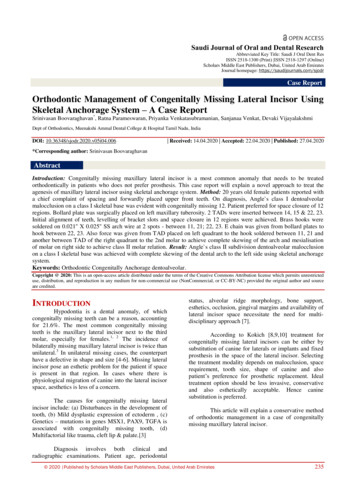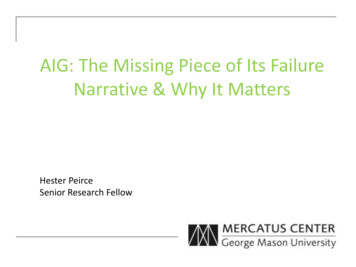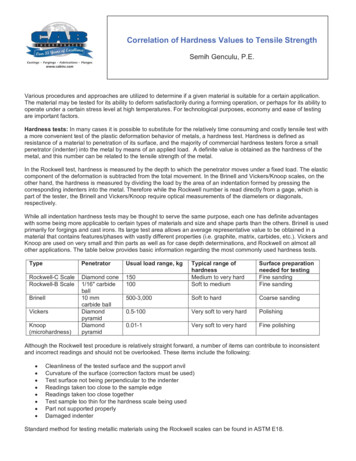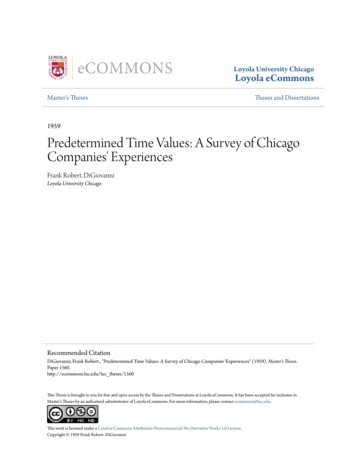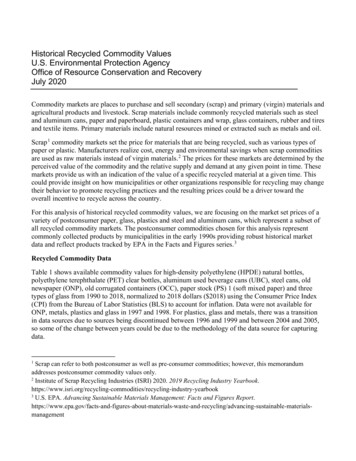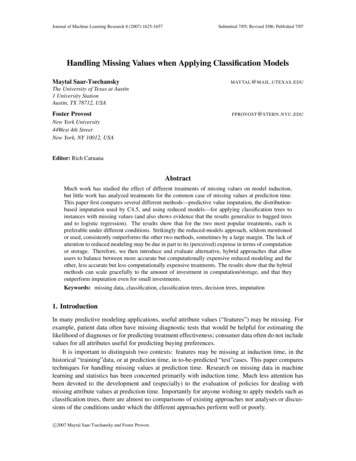
Transcription
Journal of Machine Learning Research 8 (2007) 1625-1657Submitted 7/05; Revised 5/06; Published 7/07Handling Missing Values when Applying Classification ModelsMaytal Saar-TsechanskyMAYTAL @ MAIL . UTEXAS . EDUThe University of Texas at Austin1 University StationAustin, TX 78712, USAFoster ProvostFPROVOST @ STERN . NYU . EDUNew York University44West 4th StreetNew York, NY 10012, USAEditor: Rich CaruanaAbstractMuch work has studied the effect of different treatments of missing values on model induction,but little work has analyzed treatments for the common case of missing values at prediction time.This paper first compares several different methods—predictive value imputation, the distributionbased imputation used by C4.5, and using reduced models—for applying classification trees toinstances with missing values (and also shows evidence that the results generalize to bagged treesand to logistic regression). The results show that for the two most popular treatments, each ispreferable under different conditions. Strikingly the reduced-models approach, seldom mentionedor used, consistently outperforms the other two methods, sometimes by a large margin. The lack ofattention to reduced modeling may be due in part to its (perceived) expense in terms of computationor storage. Therefore, we then introduce and evaluate alternative, hybrid approaches that allowusers to balance between more accurate but computationally expensive reduced modeling and theother, less accurate but less computationally expensive treatments. The results show that the hybridmethods can scale gracefully to the amount of investment in computation/storage, and that theyoutperform imputation even for small investments.Keywords: missing data, classification, classification trees, decision trees, imputation1. IntroductionIn many predictive modeling applications, useful attribute values (“features”) may be missing. Forexample, patient data often have missing diagnostic tests that would be helpful for estimating thelikelihood of diagnoses or for predicting treatment effectiveness; consumer data often do not includevalues for all attributes useful for predicting buying preferences.It is important to distinguish two contexts: features may be missing at induction time, in thehistorical “training”data, or at prediction time, in to-be-predicted “test”cases. This paper comparestechniques for handling missing values at prediction time. Research on missing data in machinelearning and statistics has been concerned primarily with induction time. Much less attention hasbeen devoted to the development and (especially) to the evaluation of policies for dealing withmissing attribute values at prediction time. Importantly for anyone wishing to apply models such asclassification trees, there are almost no comparisons of existing approaches nor analyses or discussions of the conditions under which the different approaches perform well or poorly.c 2007 Maytal Saar-Tsechansky and Foster Provost.
S AAR -T SECHANSKY AND P ROVOSTAlthough we show some evidence that our results generalize to other induction algorithms, wefocus on classification trees. Classification trees are employed widely to support decision-makingunder uncertainty, both by practitioners (for diagnosis, for predicting customers’ preferences, etc.)and by researchers constructing higher-level systems. Classification trees commonly are used asstand-alone classifiers for applications where model comprehensibility is important, as base classifiers in classifier ensembles, as components of larger intelligent systems, as the basis of morecomplex models such as logistic model trees (Landwehr et al., 2005), and as components of or toolsfor the development of graphical models such as Bayesian networks (Friedman and Goldszmidt,1996), dependency networks (Heckerman et al., 2000), and probabilistic relational models (Getooret al., 2002; Neville and Jensen, 2007). Furthermore, when combined into ensembles via bagging(Breiman, 1996), classification trees have been shown to produce accurate and well-calibrated probability estimates (Niculescu-Mizil and Caruana, 2005).This paper studies the effect on prediction accuracy of several methods for dealing with missingfeatures at prediction time. The most common approaches for dealing with missing features involveimputation (Hastie et al., 2001). The main idea of imputation is that if an important feature ismissing for a particular instance, it can be estimated from the data that are present. There aretwo main families of imputation approaches: (predictive) value imputation and distribution-basedimputation. Value imputation estimates a value to be used by the model in place of the missingfeature. Distribution-based imputation estimates the conditional distribution of the missing value,and predictions will be based on this estimated distribution. Value imputation is more common inthe statistics community; distribution-based imputation is the basis for the most popular treatmentused by the (non-Bayesian) machine learning community, as exemplified by C4.5 (Quinlan, 1993).An alternative to imputation is to construct models that employ only those features that willbe known for a particular test case—so imputation is not necessary. We refer to these models asreduced-feature models, as they are induced using only a subset of the features that are availablefor the training data. Clearly, for each unique pattern of missing features, a different model wouldbe used for prediction. We are aware of little prior research or practice using this method. Itwas treated to some extent in papers (discussed below) by Schuurmans and Greiner (1997) and byFriedman et al. (1996), but was not compared broadly to other approaches, and has not caught on inmachine learning research or practice.The contribution of this paper is twofold. First, it presents a comprehensive empirical comparison of these different missing-value treatments using a suite of benchmark data sets, and a follow-uptheoretical discussion. The empirical evaluation clearly shows the inferiority of the two commonimputation treatments, highlighting the underappreciated reduced-model method. Curiously, thepredictive performance of the methods is more-or-less in inverse order of their use (at least in AIwork using tree induction). Neither of the two imputation techniques dominates cleanly, and eachprovides considerable advantage over the other for some domains. The follow-up discussion examines the conditions under which the two imputation methods perform better or worse.Second, since using reduced-feature models can be computationally expensive, we introduceand evaluate hybrid methods that allow one to manage the tradeoff between storage/computationcost and predictive performance, showing that even a small amount of storage/computation canresult in a considerable improvement in generalization performance.1626
H ANDLING M ISSING VALUES WHEN A PPLYING C LASSIFICATION M ODELS2. Treatments for Missing Values at Prediction TimeLittle and Rubin (1987) identify scenarios for missing values, pertaining to dependencies betweenthe values of attributes and the missingness of attributes. Missing Completely At Random (MCAR)refers to the scenario where missingness of feature values is independent of the feature values (observed or not). For most of this study we assume missing values occur completely at random. Indiscussing limitations below, we note that this scenario may not hold for practical problems (e.g.,Greiner et al., 1997a); nonetheless, it is a general and commonly assumed scenario that shouldbe understood before moving to other analyses, especially since most imputation methods rely onMCAR for their validity (Hastie et al., 2001). Furthermore, Ding and Simonoff (2006) show that theperformance of missing-value treatments used when training classification trees seems unrelated tothe Little and Rubin taxonomy, as long as missingness does not depend on the class value (in whichcase unique-value imputation should be used, as discussed below, as long as the same relationshipwill hold in the prediction setting).When features are missing in test instances, there are several alternative courses of action.1. Discard instances: Simply discarding instances with missing values is an approach oftentaken by researchers wanting to assess the performance of a learning method on data drawnfrom some population. For such an assessment, this strategy is appropriate if the featuresare missing completely at random. (It often is used anyway.) In practice, at prediction time,discarding instances with missing feature values may be appropriate when it is plausible todecline to make a prediction on some cases. In order to maximize utility it is necessary toknow the cost of inaction as well as the cost of prediction error. For the purpose of this studywe assume that predictions are required for all test instances.2. Acquire missing values. In practice, a missing value may be obtainable by incurring a cost,such as the cost of performing a diagnostic test or the cost of acquiring consumer data from athird party. To maximize expected utility one must estimate the expected added utility frombuying the value, as well as that of the most effective missing-value treatment. Buying amissing value is only appropriate when the expected net utility from acquisition exceeds thatof the alternative. However, this decision requires a clear understanding of the alternativesand their relative performances—a motivation for this study.3. Imputation. As introduced above, imputation is a class of methods by which an estimation ofthe missing value or of its distribution is used to generate predictions from a given model. Inparticular, either a missing value is replaced with an estimation of the value or alternativelythe distribution of possible missing values is estimated and corresponding model predictionsare combined probabilistically. Various imputation treatments for missing values in historical/training data are available that may also be deployed at prediction time. However, sometreatments such as multiple imputation (Rubin, 1987) are particularly suitable to induction.In particular, multiple imputation (or repeated imputation) is a Monte Carlo approach thatgenerates multiple simulated versions of a data set that each are analyzed and the results arecombined to generate inference. For this paper, we consider imputation techniques that canbe applied to individual test cases during inference.11. As a sanity check, we performed inference using a degenerate, single-case multiple imputation, but it performed nobetter and often worse than predictive value imputation.1627
S AAR -T SECHANSKY AND P ROVOST(a) (Predictive) Value Imputation (PVI): With value imputation, missing values are replacedwith estimated values before applying a model. Imputation methods vary in complexity.For example, a common approach in practice is to replace a missing value with the attribute’s mean or mode value (for real-valued or discrete-valued attributes, respectively)as estimated from the training data. An alternative is to impute with the average of thevalues of the other attributes of the test case.2More rigorous estimations use predictive models that induce a relationship between theavailable attribute values and the missing feature. Most commercial modeling packagesoffer procedures for predictive value imputation. The method of surrogate splits forclassification trees (Breiman et al., 1984) imputes based on the value of another feature,assigning the instance to a subtree based on the imputed value. As noted by Quinlan(1993), this approach is a special case of predictive value imputation.(b) Distribution-based Imputation (DBI). Given a (estimated) distribution over the values ofan attribute, one may estimate the expected distribution of the target variable (weightingthe possible assignments of the missing values). This strategy is common for applyingclassification trees in AI research and practice, because it is the basis for the missing value treatment implemented in the commonly used tree induction program, C4.5(Quinlan, 1993). Specifically, when the C4.5 algorithm is classifying an instance, and atest regarding a missing value is encountered, the example is split into multiple pseudoinstances each with a different value for the missing feature and a weight correspondingto the estimated probability for the particular missing value (based on the frequency ofvalues at this split in the training data). Each pseudo-instance is routed down the appropriate tree branch according to its assigned value. Upon reaching a leaf node, theclass-membership probability of the pseudo-instance is assigned as the frequency of theclass in the training instances associated with this leaf. The overall estimated probabilityof class membership is calculated as the weighted average of class membership probabilities over all pseudo-instances. If there is more than one missing value, the processrecurses with the weights combining multiplicatively. This treatment is fundamentallydifferent from value imputation because it combines the classifications across the distribution of an attribute’s possible values, rather than merely making the classificationbased on its most likely value. In Section 3.3 we will return to this distinction whenanalyzing the conditions under which each technique is preferable.(c) Unique-value imputation. Rather than estimating an unknown feature value it is possibleto replace each missing value with an arbitrary unique value. Unique-value imputationis preferable when the following two conditions hold: the fact that a value is missingdepends on the value of the class variable, and this dependence is present both in thetraining and in the application/test data (Ding and Simonoff, 2006).4. Reduced-feature Models: Imputation is required when the model being applied employs anattribute whose value is missing in the test instance. A
Research on missing data in machine learning and statistics has been concerned primarily with induction time. Much less attention has been devoted to the development and (especially) to the evaluation of policies for dealing with missing attribute values at prediction time. Importantly for anyone wishing to apply models such as classification trees, there are almost no comparisons of existing .
